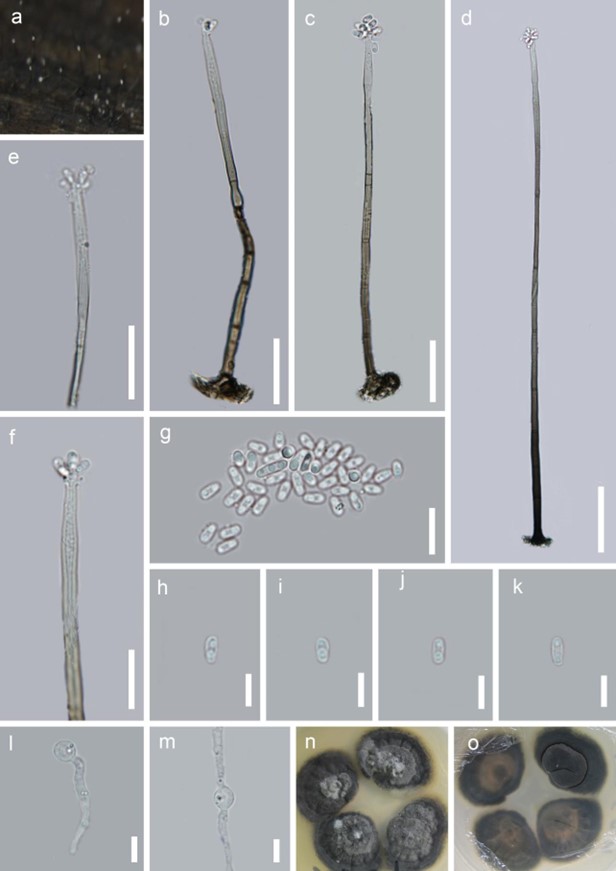Chloridium submersum Z.L. Luo, K.D. Hyde & H.Y. Su, sp. nov. Fig. 69
MycoBank number: MB 556752; Index Fungorum number: IF 556752; Facesoffungi number: FoF 06866;
Etymology – Referring to the submerged habitat of this fungus.
Holotype – MFLU 18-1609.
Saprobic on submerged decaying wood. Sexual morph: Undetermined. Asexual morph: Colonies effuse, brown, with long hairy mycelium, with white glistening conidial mass. Mycelium partly immersed, partly superficial, consisting of branched, septate, brown hyphae. Conidiophores 116–264(–350) µm ( x = 190 µm, SD = 74, n = 10) long, 4–6 μm ( x = 5 µm, SD = 1, n = 10) wide, macronematous, mononematous, erect, straight or slightly flexuous, septate, brown at the base, gradually becoming paler towards apex, smooth. Conidiogenous cells integrated, terminal, poly- enteroblastic, with a conspicuous outer collarette, hyaline. Conidia 3.5–4.5 µm ( x = 4 µm, SD = 0.5, n = 30) long, 2–3 μm ( x = 2.5 µm, SD = 0.5, n = 30) wide, acrogenous, aggregated in slimy mass at the apex of the conidiophore, ellipsoid, hyaline, aseptate, guttulate, smooth.
Material examined – CHINA, Yunnan Province, saprobic on decaying submerged wood in Dulong river, May 2015, H.Y. Su, H D5-13-1, S-510, MFLU 18-1609, holotype; ex-type living culture, MFLUCC 16-1344.
GenBank numbers – ITS MN860551, LSU MN860556.
Notes – Chloridium submersum resembles C. phaeosporum in having macronematous, mononematous, erect, septate conidiophores which are brown at the base, gradually becoming paler towards apex, terminal, hyaline conidiogenous cells and ellipsoid, hyaline, aseptate conidia (Wu & Zhang 2013). However, C. submersum differs from C. phaeosporum by its longer conidiophores (116–264(–350) vs 70–120 µm), polyblastic, denticulate conidiogenous cells and guttulate, hyaline conidia, while the latter species have monophialidic conidiogenous cells constricting abruptly and expanding in a flaring collarette and pale brown conidia without guttules. Chloridium submersum is phylogenetically related to C. aquaticum, C. gonythichii and C. aseptatum (Fig. 8).

Figure 69 – Chloridium submersum (MFLU 18-1609, holotype). a Colonies on wood. b-d Conidiophores with conidia. e, f Conidiogenous cells. g-k Conidia. l, m Germinating conidia. n, o Culture on PDA from surface and reverse. Scale bars: b-d = 100 μm, e, f = 30 μm, g = 10 μm, h-m = 5 μm.

Figure 8 – Phylogram generated from maximum likelihood analysis based on combined LSU and ITS sequence data of Chaetosphaeriales and Tracyllalales taxa. Ninety-six strains are included in the combined analyses which comprised 1695 characters (1081 characters for LSU, 614 characters for ITS) after alignment. Neurospora crassa MUCL 19026 and Gelasinospora tetrasperma CBS 178.33 (Sordariaceae, Sordariales) are used as outgroup taxa. Single gene analyses were carried out and the phylogenies were similar in topology and clade stability. Tree topology of the maximum likelihood analysis is similar to the Bayesian analysis. The best RaxML tree with a final likelihood value of – 23777.689886 is presented. Estimated base frequencies were as follows: A = 0.231060, C = 0.264793, G = 0.308265, T = 0.195882; substitution rates AC = 1.388486, AG = 1.836207, AT = 1.649563, CG = 0.971659, CT = 6.316962, GT = 1.000000; gamma distribution shape parameter a = 0.460297. Bootstrap support values for ML greater than 75% and Bayesian posterior probabilities greater than 0.95 are given near the nodes. Ex-type strains are in bold. The newly generated sequences are indicated in blue.

Figure 8 – Continued.
